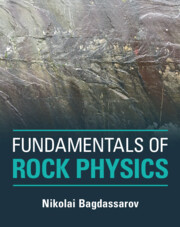Book contents
- Fundamentals of Rock Physics
- Fundamentals of Rock Physics
- Copyright page
- Dedication
- Contents
- Preface
- 1 Introduction
- 2 Density and Porosity
- 3 Stresses in Rocks
- 4 Mechanical Strain and Elastic Moduli
- 5 Permeability of Rocks
- 6 Mechanical Properties of Fluid-Bearing Rocks
- 7 Acoustic Properties of Rocks
- 8 Electric Resistivity
- 9 Dielectric Properties
- 10 Magnetic Properties of Rocks
- 11 Thermal Properties of Rocks and Minerals
- 12 Radioactive Properties of Rocks
- Index
- References
9 - Dielectric Properties
Published online by Cambridge University Press: 19 November 2021
- Fundamentals of Rock Physics
- Fundamentals of Rock Physics
- Copyright page
- Dedication
- Contents
- Preface
- 1 Introduction
- 2 Density and Porosity
- 3 Stresses in Rocks
- 4 Mechanical Strain and Elastic Moduli
- 5 Permeability of Rocks
- 6 Mechanical Properties of Fluid-Bearing Rocks
- 7 Acoustic Properties of Rocks
- 8 Electric Resistivity
- 9 Dielectric Properties
- 10 Magnetic Properties of Rocks
- 11 Thermal Properties of Rocks and Minerals
- 12 Radioactive Properties of Rocks
- Index
- References
Summary
Displacement current and bounded electrical charges are responsible for rock polarization. Dielectric constant: Debye, Cole–Cole or Havriliak–Negami models. Three types of bulk polarization: polarization due to dipoles, ionic polarization, and electronic polarization. Interface polarization on grain boundaries is explained by the Maxwell–Wagner effect. At grain boundaries in contact with electrolyte fluid, electrical double layer is described by the Gouy–Chapman–Stern model. Reaction mechanisms between SiO2 and H2O may take place. Increased electrolyte concentration results in increased surface energy. Electrical flux density and dielectric losses. Dielectric properties of rocks. Energy transport, transmission and reflection coefficients of minerals for electromagnetic waves in rocks. Induced polarization of rocks. Mixing models for dielectric constant: effective medium approach, Wiener and Hashin–Shtrikman bounds, Lorenz equation and percolation model. Factors causing induced polarization in rocks and the Pelton model. Focus Box 9.1: Maxwell’s equations. Focus Box 9.2: Lorenz field and Clausius–Mossotti equation. Focus Box 9.3: Redox reactions, Warburg impedance, Nyquist plots.
Keywords
- Type
- Chapter
- Information
- Fundamentals of Rock Physics , pp. 361 - 413Publisher: Cambridge University PressPrint publication year: 2021



